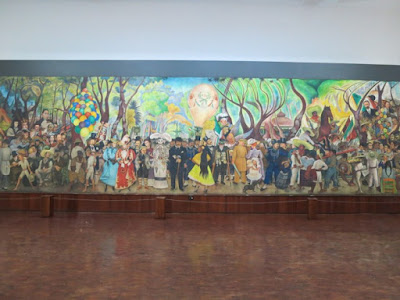The artistic works of Diego Rivera (1886-1957) are on view in many
Mexico City buildings and attract hordes of tourists ‒
locals and international alike. The Palacio Nacional (with
Rivera's "The History of Mexico") and Palacio de Bellas
Artes are but two instances of many; the home he shared with Frida
Kahlo is another. Rivera is an artistic icon, one of the world's
greatest muralists; his frescoes are usually of epic size, a medium
in which he truly found his expression. Tumultuous times affected him
—
the Mexican Revolution, the
Russian Revolution, social injustice;
his Marxist and anti-religious convictions made him personally
controversial —
yet they drove his creative energy. The impoverished
working classes and
indigenous images
are often his subjects.
What we wanted to find were slightly offbeat sites or possibly
less-crowded venues. Tipped off by a friend, we headed across Alameda
Park to find the Diego Rivera Mural Museum. We did find it after
circling several blocks, distracted —
not unhappily —
by sidewalk vendors.
But find it we did. The small museum is devoted to one fresco, "Dream
of a Sunday Afternoon in Alameda Park" (1947), certainly one of
Rivera's best-known works. Originally created for a hotel, it was
saved from demolition at one point and moved into its own custom
space. It's fifty-one feet long, but being populated by some 400
figures is perhaps a better way to measure it!
The historical
panoply amazes and captivates. From Conquest to twentieth century,
Rivera has inserted people and scenes that offer a story or social
commentary. Disdain of the upper classes was perhaps his mildest
theme. Printed diagrams will show you who these people are, or who
they represent, all partaking of a fine day in the park, in his
dream. In a prominent section, the artist depicts himself as a
youngster with his wife Frida behind him. Holding his hand is the
now-famous Catrina figure created by José
Posada, also portrayed (not shown here) on the skeleton's left.
There's no shortage of information out there about Rivera, but I did
like this charming essay about Dream of a Sunday Afternoon:
Directions to reach
our next destination were rather vague but eventually a quiet section
of Chapultepec Park provided the ultimate reward.
Meet TLÁLOC,
Meso-American god of rain. This is not just a fountain. When
the city decided to completely repair and update its water system,
Rivera was commissioned in 1950 to create a public monument
celebrating water as life's essential element. The resulting Fuente
de Tláloc,
to my mind, is a masterpiece, exhibiting his deep feeling for
indigenous lore. Sculpture makes quite a difference from painted
frescoes although it's not the first time he used mosaic tiles.
The small adjacent building (El Cárcamo
del Dolores) that houses the pumping station now displays photographs
and articles about Rivera's work there. He painted a mural on the four sides of the water tank, paying tribute to
the precious resource; you have clear views of each colourful
side of the concrete tank (no longer in use).
Ironically, the mural deteriorated so badly over fifty years of water
flow that the complex was finally closed to the public. But funds
were raised in 2010 to restore it. A unique bonus is the ingenious sound installation by Ariel Guzik —
the technological terminology of the engineering is beyond me —
but "basically
a real time sound interpretation of three elements: the sun, the wind
and the water."[1]
It's
a type of organ playing natural sounds we can't ordinarily hear,
quite ethereal.
A
mere
handful of visitors
were around while we were there. Outside in the park itself are four
large garden-like circles of low walls, each surrounding a tower
below which are huge water storage tanks. By walking around them we
discovered that each circle was actually a sculpture of the
Quetzalcoatl serpent.
I find this photo extraordinary. Taken almost as an afterthought. This
is the back of Tláloc's
head, facing the Cárcamo.
So unlike the typical, implacable Tláloc
face of the recumbent figure. Water used to flow through his mouth
here from the fountain pool. How can a creation of cool mosaic tiles
make such eyes that beguile me? Is it merely the angle, the slight
cast of shadow, that capture my gaze? I feel a certain tenderness,
verging on sadness, in that expression.
Rivera
was a "countercultural
symbol of 20th century, and created a legacy in art that continues
to inspire the imagination and mind."
... "Additionally,
and perhaps most importantly, Diego Rivera took art out of the
gallery and into the public domain so that more people could enjoy
and appreciate its beauty. "[2]
©
2019 Brenda Dougall
Merriman
[1] "One of
Mexico's Hidden Treasures," Apartment 25—,
(https://apt25.com.mx/blogs/news/one-of-mexico-s-hidden-treasures).
[2] diegorivera.org.












No comments:
Post a Comment